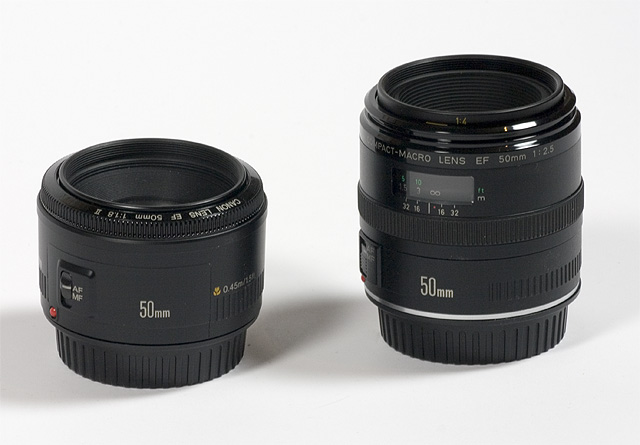|
Page 1 of 3

Review by Klaus Schroiff, published August 2005
Special thanks to Markus Stamm for providing this lens!
Introduction
The Canon EF 50mm f/2.5 macro was introduced back in december 1987 so it's one of the oldest lenses
in the line-up and it seems as if Canon has discontinued the lens with the recent introduction of the
new EF-S 60mm f/2.8 USM (w/reduced image circle). Within the scope of this test we've used an EOS 350D
so here the field-of-view resembles a 80mm lens on a full frame camera. The primary application
of the lens is, obviously, macro photography but it's not limited to that - infinity focus is possible -
so it can replace normal standard lenses if you can live with the smaller max. aperture.

The lens features a conventional micro motor without full-time manual focusing.
The AF speed is reasonably fast unless the camera thinks that it needs to hunt through the
focusing range. In this case be prepared to wait quite a while. The lack of a focus limiter doesn't
help here either. AF accuracy could be better on the EOS 350D.
The lens uses a linear extension system for focusing (similar to extension tubes) so the length of
the lens changes according to the focus distance. The front element does not rotate during focusing.
The minimal focus distance is 0.23m resulting in a max. magnification of 1:2. Using a dedicated
but optional life-size converter you can achieve a magnifications between 1:4 and 1:1 at increased working
distances.
Using the converter you loose 1 f-stops (f/3.5) and the combination does not focus to up to infinity.
Manual focusing feels Ok. The focus ring is not exactly the smoothest around and typical for
lenses of that era the focusing action feels a little scratchy but at the end of the day it does
the job.

In case you wonder about the magnification numbers on the inner lens barrel: this refers to the
life-size converter combination (1:4 - 1:1).
The optical construction is made of just 9 elements in 8 groups without any special elements.
The lens features 6 aperture blades. Typical for all true macro lenses it features a floating
system in order to achieve a constant performance throughout all focusing distances. The filter
size is 52mm.
At just 280g it is a very light-weight lens and with a dimension of 67x63mm it's also quite compact.
That said it's still a little bigger than conventional 50mm lenses. Here's a comparison to the
EF 50mm f/1.8 II.

The build quality is decent with a metal mount and an outer barrel made of good quality plastics.
As mentioned the focusing ring could be a little better though.
|